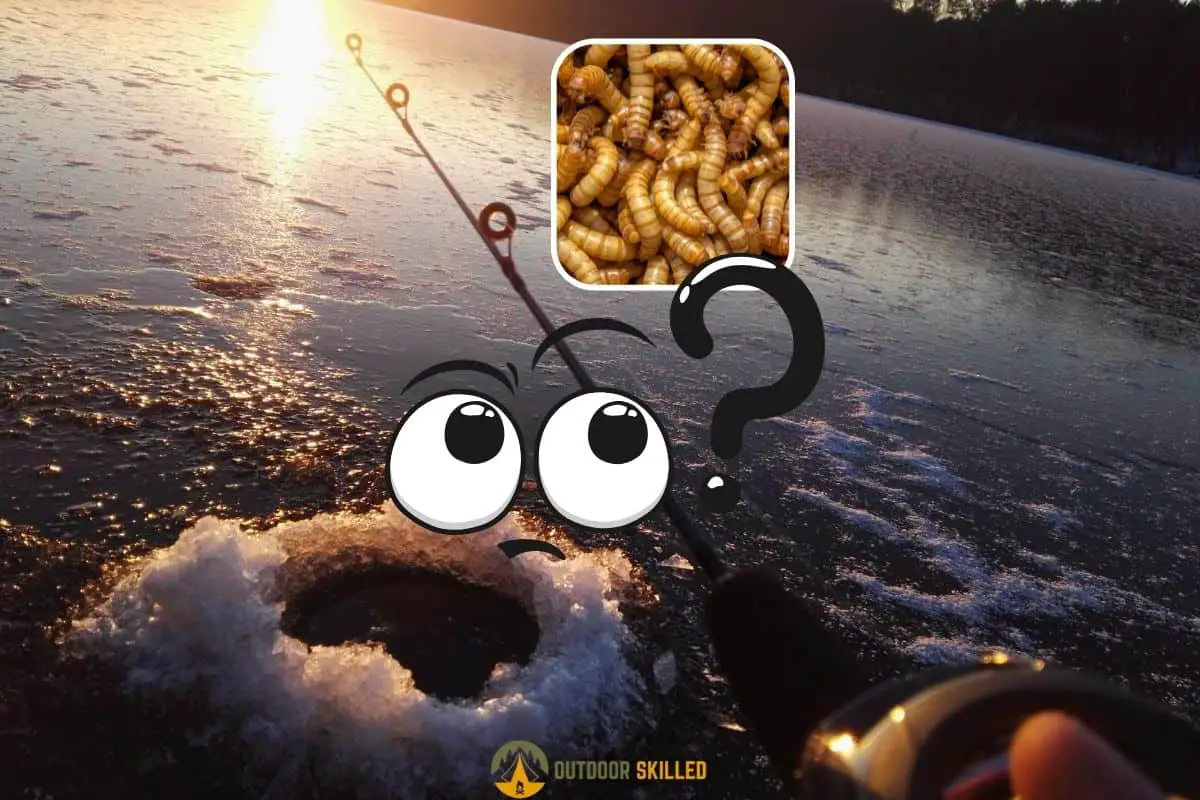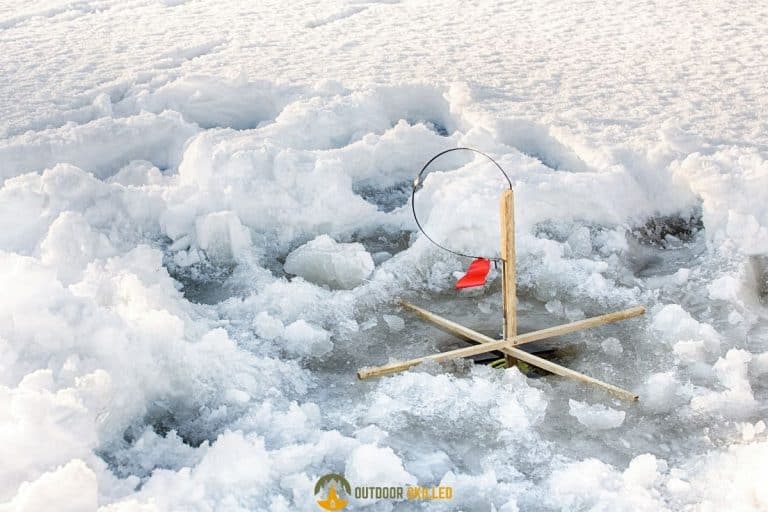Are Mealworms Good for Ice Fishing? A Guide That Gets Results
Mealworms are great for fishing on a spring day whether the fish are out in the open waters feeding or hiding in their ambush points waiting for something to grab their attention. They make excellent live bait for lots of species due to their natural scent and motion that can entice fish to strike your bait. But is this the case for ice fishing when fish are not as active?
Are mealworms good for ice fishing? Yes, mealworms are good for ice fishing. Many fish like crappie, yellow perch, bluegill, and trout would be drawn to a freshly wriggling mealworm and many fish naturally search for earthworms on the surface after they have been washed into a body of water from nearby land.
Keep reading to know more about mealworms as an effective fishing bait through the ice seasons. For a better Ice fishing experience, you can also check the best Ice Fishing Rods here and the best Ice Fishing lines here.
Table of Contents
Are Mealworms Good For Ice Fishing?

Mealworms can be versatile bait to catch lots of fish through the ice. You can use them to catch small fish as well as heavy predatory fish. Their natural motion and scent attract these fish into biting especially in extremely cold conditions.
They may not be a primary source of food for fish during winter, but they’re also hard to resist being an easy meal that doesn’t require lots of effort to catch. Fish are relatively sluggish during colder weather so they won’t say no to an easy meal such as mealworms on a jig.
Make sure your mealworms are not subject to the freezing temperatures associated with ice fishing. Until ready to use, keep your can of worms in your pocket, insulated inside your fishing storage gear, or in a warm place where it’s not freezing.
They are very easy to use. All you have to do is make up-and-down movements to attract fish. Often fish will not bite and will just watch, but wiggle the rod tip to make the bait dance to get them to bite.
What Fish Can You Catch With Mealworms Ice Fishing?
What fish can you catch ice fishing with mealworms? Many fish can be caught ice fishing with mealworms but the most common species include bluegill, trout, yellow perch, whitefish, crappie, and sometimes catfish and small bass. They work well for ice fishing because they’re an easy meal that fish don’t have to chase.
Most fish including those mentioned above tend to slow down their feeding activities during winter as their metabolism slows down in these conditions. They may be slow but they still eat if you present them with an easy meal. And mealworms make the ideal meal here.
Most fish don’t consider what they eat as long as you take care of scent and action. So make sure to use fresh and alive mealworms to allow their natural scent to attract fish.
Action is another important thing to consider; you must work your bait in a way that produces motion in the water to catch the attention of nearby fish. That’s another reason why you should use fresh mealworms as their natural wiggle draws fish from afar.
Can Dried Mealworms Be Rehydrated?
So, can dried mealworms be rehydrated? Yes, dried mealworms can be rehydrated using hot water. They won’t be as effective as fresh ones that spread natural fresh scents into the water to draw in fish but you can still use them to catch some fish.
Here is how you can rehydrate dried mealworms easily .
- Place your dried mealworms in a container that you don’t use anymore.
- Bring about 3 or 4 cups of water to a boil in a pan on your stove.
- Pour the boiled water over the dried mealworms container once it starts bubbling. Make sure they’re all covered in water. If not, add some more.
- Leave the mealworms to sit in the water for at least ½ an hour to be fully rehydrated.
- Once the ½ an hour passes, your dried mealworms should be rehydrated and ready to be used.
- Make sure they grew in size or turned to a pale color in an indication they absorbed enough water.
- Keep them in a damp dark container until you’re ready to use them. Make sure it’s not too cold and keep them in a warm space when you go on the ice.
If you want another way to save them other than drying them, try keeping them in a dark enclosed container and feed them once a week. You can keep them in a refrigerator alive and fresh for several months as long as you feed them and provide the right environment.
Are Mealworms Better Or Super Worms?
Generally, mealworms will give about the same sustenance a super worm will give, with little difference. For example, a super worm is around 5 times larger than a mealworm when you take into account texture and length.
The majority of the size difference is due to a super worm having more chitin than mealworms. This leaves them with less meat but more protein, carbohydrate, and fat. Another distinction is the inability to refrigerate super worms in order to keep them in a state of hibernation before the next fishing trip.
What can put mealworms on top is that they’re high in protein and fish can detect especially fish that feed on other high in protein fish. The mealworm protein level is 20.3% while the super worm protein level is less than 17%.
So we came to a conclusion that mealworms are better fish attractant but still, when you’re after fish that prefer big meals in specific conditions, it’s better to pick super worms.
8 Tips To Get The Best Results With Mealworms For Ice Fishing
- Use a small size 6 or 8 hooks. Lightly hook mealworms so it wiggles a lot as this motion is a huge fish attractant.
- Use a lead or tungsten head jig. It’ll help pull that bait down between jigging motions. Mealworms are not heavy enough to be jigged alone with effective motion.
- Cut mealworms into thirds. This will allow the scent to spread faster in the water and catch the interest of nearby fish.
- Keep them in dark, damp containers. This way it’s fresher and better for your fishing.
- Use green or red jigs. These colors work best with mealworms and stand out well in the water.
- Don’t try mealworms with lake trout, pike, muskies, pickerel, and bass. If you don’t want to waste your time with fish that don’t really have an interest in earthworms, avoid these species and go for alternative baits.
- Pick the right depth. Make sure to know exactly at which depth does your target fish roam in to cast your bait right above the fish nose.
- Fish slow and steady. Don’t overwork your bait or send rapid motions, fish during colder seasons tend to slow down their feeding activities and won’t bite a meal that requires much effort to catch.
If you found this article helpful don’t forget to pin/share it on Pinterest to help more live bait fans to make exceptional results with mealworms.
Related Questions
What are the most effective live baits for most fish?
The most effective live baits that work for most fish are wax worms, mealworms, mudpuppies, as well as bait fish like shiners, suckers, shad, and bluegill. To guarantee that you are fishing safely using these baits, you must first consult with your state and review the local regulations.
How long do mealworms live in the refrigerator?
Mealworms can live in the refrigerator for up to two weeks with very little maintenance. After two weeks, remove the mealworms from the refrigerator and apply a small amount of Easy Water to the top of the bedding. Enable the mealworms to rest at room temperature for approximately 24 hours.
Can crappies be caught on mealworms?
Yes, crappies can be caught on mealworms. They make excellent ice fishing bait for crappie in the winter. When dressed into a small jig head or rigged solo onto a baited hook, both mealworms and waxworms will perform well for warm-season crappie.
Helpful Resources
What Kind Of Fish Can You Catch With Mealworms?
If you like this article, please share it or pin it, you can find the share buttons below. We will really appreciate it ❤️


